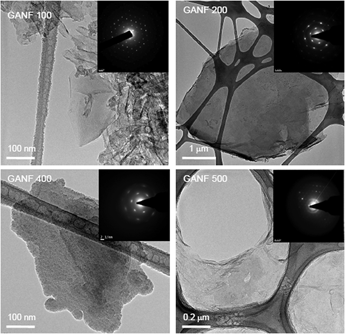Crossref Citations
This article has been cited by the following publications. This list is generated based on data provided by
Crossref.
Varela-Rizo, Helena
Martín-Gullón, Ignacio
and
Terrones, Mauricio
2012.
Hybrid Films with Graphene Oxide and Metal Nanoparticles Could Now Replace Indium Tin Oxide.
ACS Nano,
Vol. 6,
Issue. 6,
p.
4565.
Terrones, Mauricio
2012.
Controlling the shapes and assemblages of graphene.
Proceedings of the National Academy of Sciences,
Vol. 109,
Issue. 21,
p.
7951.
López‐Díaz, David
Mercedes Velázquez, Maria
Blanco de La Torre, Santiago
Pérez‐Pisonero, Ana
Trujillano, Raquel
Fierro, José Luis García
Claramunt, Sergi
and
Cirera, Albert
2013.
The Role of Oxidative Debris on Graphene Oxide Films.
ChemPhysChem,
Vol. 14,
Issue. 17,
p.
4002.
Claramunt, Sergi
Varea, Aïda
López-Díaz, David
Velázquez, M. Mercedes
Cornet, Albert
and
Cirera, Albert
2015.
The Importance of Interbands on the Interpretation of the Raman Spectrum of Graphene Oxide.
The Journal of Physical Chemistry C,
Vol. 119,
Issue. 18,
p.
10123.
Abdul Rashid, Suraya
Mohd Zobir, Syazwan Afif
Krishnan, Shutesh
Hassan, Mohd Murshid
and
Lim, Hong Ngee
2015.
One-pot synthesis of graphene oxide sheets and graphene oxide quantum dots from graphite nanofibers.
Journal of Nanoparticle Research,
Vol. 17,
Issue. 5,
Lobato, B.
Merino, C.
Barranco, V.
and
Centeno, T. A.
2016.
Large-scale conversion of helical-ribbon carbon nanofibers to a variety of graphene-related materials.
RSC Advances,
Vol. 6,
Issue. 62,
p.
57514.
García-Gallegos, J C
Martín-Gullón, I
Conesa, J A
Vega-Cantú, Y I
and
Rodríguez-Macías, F J
2016.
The effect of carbon nanofillers on the performance of electromechanical polyaniline-based composite actuators.
Nanotechnology,
Vol. 27,
Issue. 1,
p.
015501.
Rodríguez-García, S.
Santiago, R.
López-Díaz, D.
Merchán, M. D.
Velázquez, M. M.
Fierro, J. L. G.
and
Palomar, J.
2019.
Role of the Structure of Graphene Oxide Sheets on the CO2 Adsorption Properties of Nanocomposites Based on Graphene Oxide and Polyaniline or Fe3O4-Nanoparticles.
ACS Sustainable Chemistry & Engineering,
Lavin-Lopez, M.P.
Patón-Carrero, A.
Muñoz-Garcia, N.
Enguilo, V.
Valverde, J.L.
and
Romero, A.
2019.
The influence of graphite particle size on the synthesis of graphene-based materials and their adsorption capacity.
Colloids and Surfaces A: Physicochemical and Engineering Aspects,
Vol. 582,
Issue. ,
p.
123935.
Romero, A.
Lavin-Lopez, M.P.
Sánchez-Silva, M.L.
Valverde, J.L.
and
Paton-Carrero, A.
2020.
Effects of oxidizing procedures on carbon nanofibers surface and dispersability in an epoxy resin.
Materials Chemistry and Physics,
Vol. 243,
Issue. ,
p.
122571.
Backes, Claudia
Abdelkader, Amr M
Alonso, Concepción
Andrieux-Ledier, Amandine
Arenal, Raul
Azpeitia, Jon
Balakrishnan, Nilanthy
Banszerus, Luca
Barjon, Julien
Bartali, Ruben
Bellani, Sebastiano
Berger, Claire
Berger, Reinhard
Ortega, M M Bernal
Bernard, Carlo
Beton, Peter H
Beyer, André
Bianco, Alberto
Bøggild, Peter
Bonaccorso, Francesco
Barin, Gabriela Borin
Botas, Cristina
Bueno, Rebeca A
Carriazo, Daniel
Castellanos-Gomez, Andres
Christian, Meganne
Ciesielski, Artur
Ciuk, Tymoteusz
Cole, Matthew T
Coleman, Jonathan
Coletti, Camilla
Crema, Luigi
Cun, Huanyao
Dasler, Daniela
De Fazio, Domenico
Díez, Noel
Drieschner, Simon
Duesberg, Georg S
Fasel, Roman
Feng, Xinliang
Fina, Alberto
Forti, Stiven
Galiotis, Costas
Garberoglio, Giovanni
García, Jorge M
Garrido, Jose Antonio
Gibertini, Marco
Gölzhäuser, Armin
Gómez, Julio
Greber, Thomas
Hauke, Frank
Hemmi, Adrian
Hernandez-Rodriguez, Irene
Hirsch, Andreas
Hodge, Stephen A
Huttel, Yves
Jepsen, Peter U
Jimenez, Ignacio
Kaiser, Ute
Kaplas, Tommi
Kim, HoKwon
Kis, Andras
Papagelis, Konstantinos
Kostarelos, Kostas
Krajewska, Aleksandra
Lee, Kangho
Li, Changfeng
Lipsanen, Harri
Liscio, Andrea
Lohe, Martin R
Loiseau, Annick
Lombardi, Lucia
Francisca López, Maria
Martin, Oliver
Martín, Cristina
Martínez, Lidia
Martin-Gago, Jose Angel
Ignacio Martínez, José
Marzari, Nicola
Mayoral, Álvaro
McManus, John
Melucci, Manuela
Méndez, Javier
Merino, Cesar
Merino, Pablo
Meyer, Andreas P
Miniussi, Elisa
Miseikis, Vaidotas
Mishra, Neeraj
Morandi, Vittorio
Munuera, Carmen
Muñoz, Roberto
Nolan, Hugo
Ortolani, Luca
Ott, Anna K
Palacio, Irene
Palermo, Vincenzo
Parthenios, John
Pasternak, Iwona
Patane, Amalia
Prato, Maurizio
Prevost, Henri
Prudkovskiy, Vladimir
Pugno, Nicola
Rojo, Teófilo
Rossi, Antonio
Ruffieux, Pascal
Samorì, Paolo
Schué, Léonard
Setijadi, Eki
Seyller, Thomas
Speranza, Giorgio
Stampfer, Christoph
Stenger, Ingrid
Strupinski, Wlodek
Svirko, Yuri
Taioli, Simone
Teo, Kenneth B K
Testi, Matteo
Tomarchio, Flavia
Tortello, Mauro
Treossi, Emanuele
Turchanin, Andrey
Vazquez, Ester
Villaro, Elvira
Whelan, Patrick R
Xia, Zhenyuan
Yakimova, Rositza
Yang, Sheng
Yazdi, G Reza
Yim, Chanyoung
Yoon, Duhee
Zhang, Xianghui
Zhuang, Xiaodong
Colombo, Luigi
Ferrari, Andrea C
and
Garcia-Hernandez, Mar
2020.
Production and processing of graphene and related materials.
2D Materials,
Vol. 7,
Issue. 2,
p.
022001.
Han, Meizhao
Muhammad, Yaseen
Wei, Yunhao
Zhu, Zhaorong
Huang, Junxian
and
Li, Jing
2021.
A review on the development and application of graphene based materials for the fabrication of modified asphalt and cement.
Construction and Building Materials,
Vol. 285,
Issue. ,
p.
122885.
Alejo, T.
López-Díaz, D.
Martín-García, B.
Merchán, M.D.
Sánchez-Hidalgo, R.
and
Velázquez, M.M.
2021.
Handbook of Modern Coating Technologies.
p.
121.
